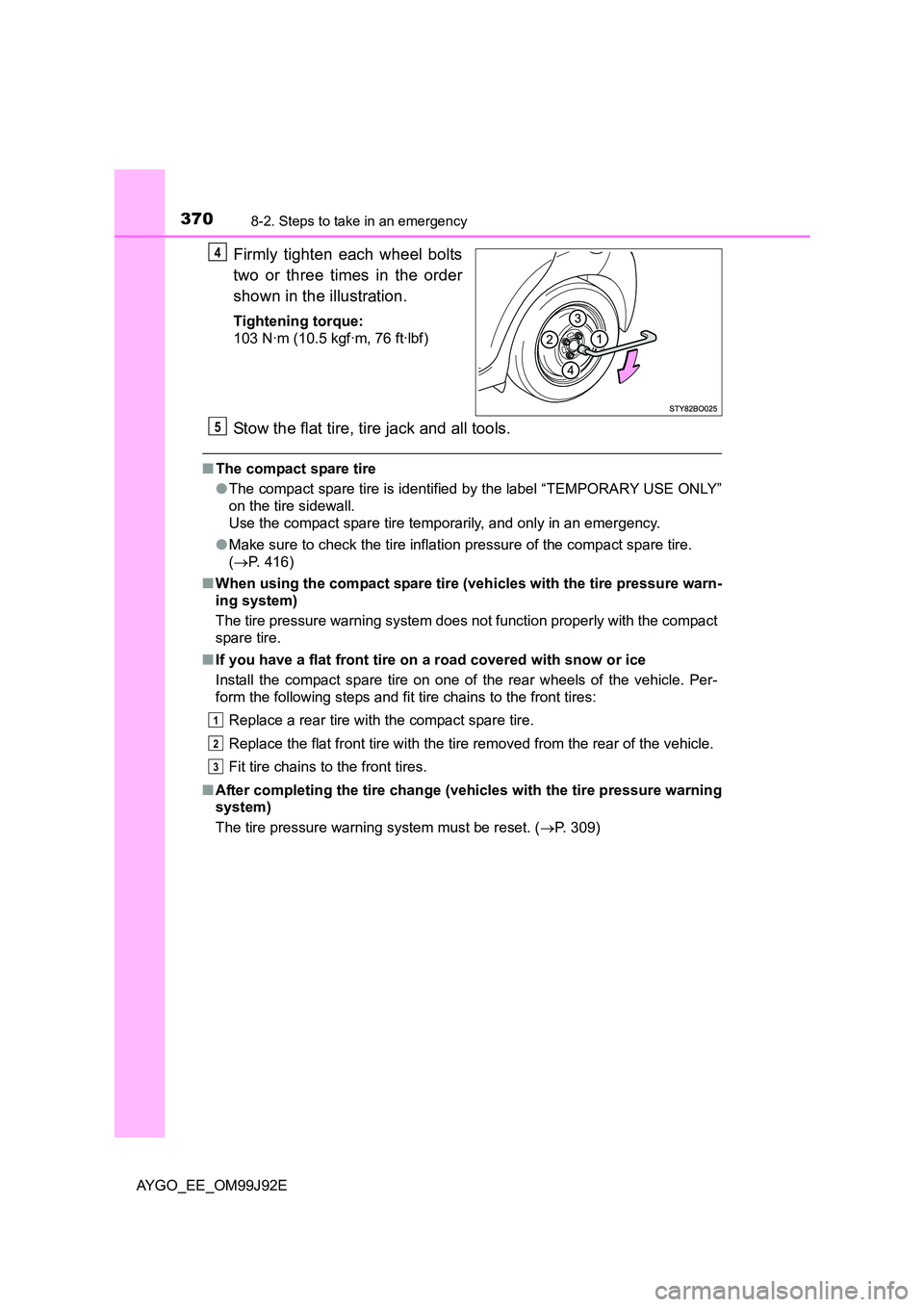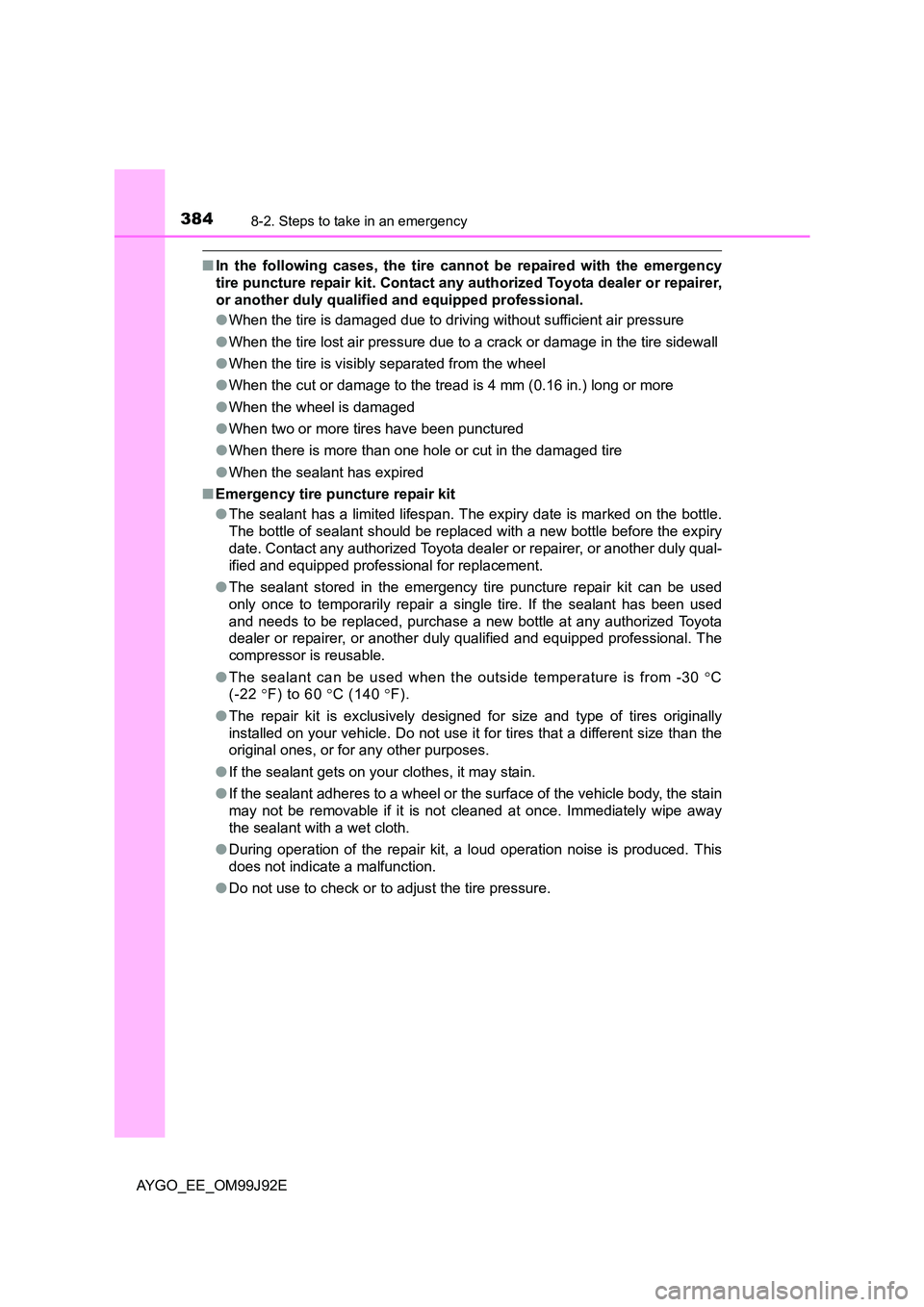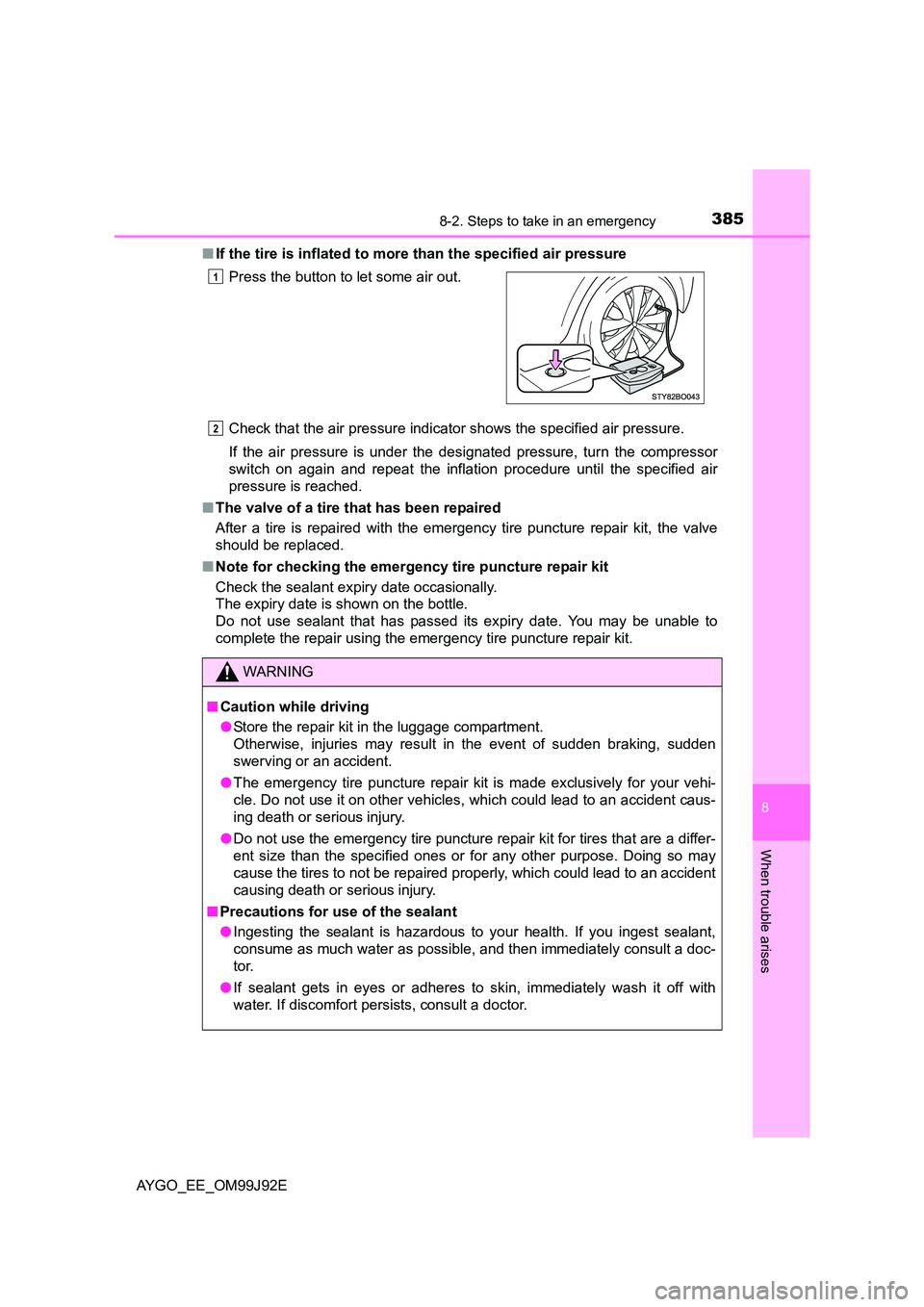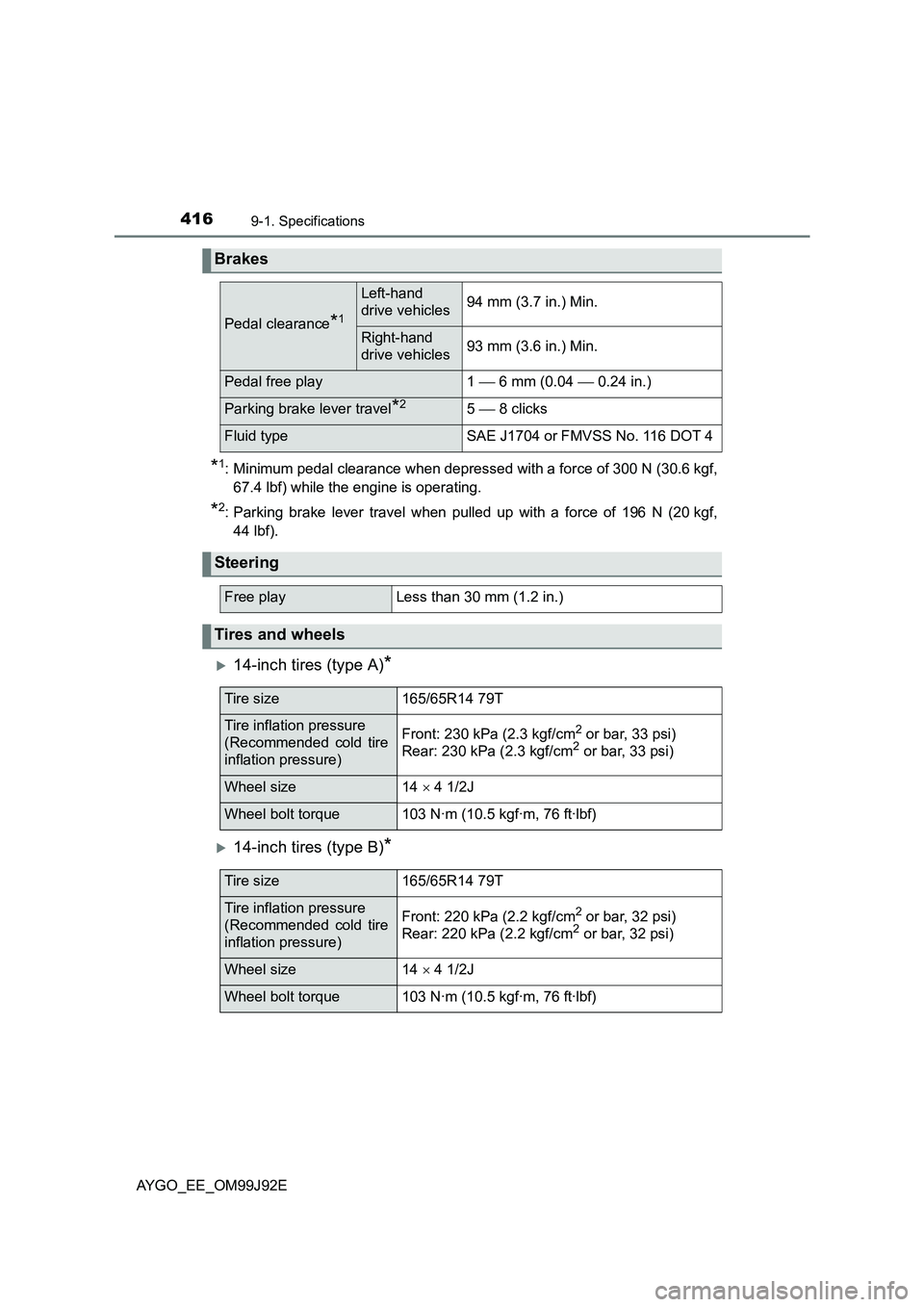Page 370 of 440

3708-2. Steps to take in an emergency
AYGO_EE_OM99J92E
Firmly tighten each wheel bolts
two or three times in the order
shown in the illustration.
Tightening torque:
103 N·m (10.5 kgf·m, 76 ft·lbf)
Stow the flat tire, tire jack and all tools.
■ The compact spare tire
● The compact spare tire is identified by the label “TEMPORARY USE ONLY”
on the tire sidewall.
Use the compact spare tire temporarily, and only in an emergency.
● Make sure to check the tire inflation pressure of the compact spare tire.
( →P. 416)
■ When using the compact spare tire (vehicles with the tire pressure warn-
ing system)
The tire pressure warning system does not function properly with the compact
spare tire.
■ If you have a flat front tire on a road covered with snow or ice
Install the compact spare tire on one of the rear wheels of the vehicle. Per-
form the following steps and fit tire chains to the front tires:
Replace a rear tire with the compact spare tire.
Replace the flat front tire with the tire removed from the rear of the vehicle.
Fit tire chains to the front tires.
■ After completing the tire change (vehicles with the tire pressure warning
system)
The tire pressure warning system must be reset. ( →P. 309)
4
5
1
2
3
Page 373 of 440
3738-2. Steps to take in an emergency
8
When trouble arises
AYGO_EE_OM99J92E
NOTICE
■ Be careful when driving over bumps with the compact spare tire
installed on the vehicle
The vehicle becomes lower when driving with the compact spare tire com-
pared to when driving with standard tires. Be careful when driving over
uneven road surfaces.
■ Driving with tire chains and the compact spare tire
Do not fit tire chains to the compact spare tire.
Tire chains may damage the vehicle body and adversely affect driving per-
formance.
Page 384 of 440

3848-2. Steps to take in an emergency
AYGO_EE_OM99J92E
■In the following cases, the tire cannot be repaired with the emergency
tire puncture repair kit. Contact any authorized Toyota dealer or repairer,
or another duly qualified and equipped professional.
● When the tire is damaged due to driving without sufficient air pressure
● When the tire lost air pressure due to a crack or damage in the tire sidewall
● When the tire is visibly separated from the wheel
● When the cut or damage to the tread is 4 mm (0.16 in.) long or more
● When the wheel is damaged
● When two or more tires have been punctured
● When there is more than one hole or cut in the damaged tire
● When the sealant has expired
■ Emergency tire puncture repair kit
● The sealant has a limited lifespan. The expiry date is marked on the bottle.
The bottle of sealant should be replaced with a new bottle before the expiry
date. Contact any authorized Toyota dealer or repairer, or another duly qual-
ified and equipped professional for replacement.
● The sealant stored in the emergency tire puncture repair kit can be used
only once to temporarily repair a single tire. If the sealant has been used
and needs to be replaced, purchase a new bottle at any authorized Toyota
dealer or repairer, or another duly qualified and equipped professional. The
compressor is reusable.
● The sealant can be used when the outside temperature is from -30 °C
(-22 °F) to 60 °C (140 °F).
● The repair kit is exclusively designed for size and type of tires originally
installed on your vehicle. Do not use it for tires that a different size than the
original ones, or for any other purposes.
● If the sealant gets on your clothes, it may stain.
● If the sealant adheres to a wheel or the surface of the vehicle body, the stain
may not be removable if it is not cleaned at once. Immediately wipe away
the sealant with a wet cloth.
● During operation of the repair kit, a loud operation noise is produced. This
does not indicate a malfunction.
● Do not use to check or to adjust the tire pressure.
Page 385 of 440

3858-2. Steps to take in an emergency
8
When trouble arises
AYGO_EE_OM99J92E
■ If the tire is inflated to more than the specified air pressure
Check that the air pressure indicator shows the specified air pressure.
If the air pressure is under the designated pressure, turn the compressor
switch on again and repeat the inflation procedure until the specified air
pressure is reached.
■ The valve of a tire that has been repaired
After a tire is repaired with the emergency tire puncture repair kit, the valve
should be replaced.
■ Note for checking the emergency tire puncture repair kit
Check the sealant expiry date occasionally.
The expiry date is shown on the bottle.
Do not use sealant that has passed its expiry date. You may be unable to
complete the repair using the emergency tire puncture repair kit.
Press the button to let some air out.
WARNING
■ Caution while driving
● Store the repair kit in the luggage compartment.
Otherwise, injuries may result in the event of sudden braking, sudden
swerving or an accident.
● The emergency tire puncture repair kit is made exclusively for your vehi-
cle. Do not use it on other vehicles, which could lead to an accident caus-
ing death or serious injury.
● Do not use the emergency tire puncture repair kit for tires that are a differ-
ent size than the specified ones or for any other purpose. Doing so may
cause the tires to not be repaired properly, which could lead to an accident
causing death or serious injury.
■ Precautions for use of the sealant
● Ingesting the sealant is hazardous to your health. If you ingest sealant,
consume as much water as possible, and then immediately consult a doc-
tor.
● If sealant gets in eyes or adheres to skin, immediately wash it off with
water. If discomfort persists, consult a doctor.
1
2
Page 402 of 440

4028-2. Steps to take in an emergency
AYGO_EE_OM99J92E
If the vehicle becomes stuck
Stop the engine. Set the parking brake and shift the shift lever to N.
Remove the mud, snow or sand from around the stuck tire.
Place wood, stones or some other material to help provide traction
under the tires.
Restart the engine.
Shift the shift lever to E, M or R (vehicles with a multi-mode manual
transmission) or 1 or R (vehicles with a manual transmission) and
release the parking brake. Then, while exercising caution, depress
the accelerator pedal.
■ When it is difficult to free the vehicle (vehicles with a VSC system)
Press to turn off TRC.
Turn off TRC and/or VSC if these functions are hampering your attempts to
free the vehicle. ( →P. 192)
■ Emergency hooks
Carry out the following procedures if the tires spin or the vehicle
becomes stuck in mud, dirt or snow:
When your vehicle becomes stuck and
cannot move, the emergency hooks are
used for another vehicle to pull your
vehicle to pull your vehicle out in an
emergency.
Your vehicle is not designed to tow
another vehicle.
1
2
3
4
5
Page 416 of 440

4169-1. Specifications
AYGO_EE_OM99J92E
*1: Minimum pedal clearance when depressed with a force of 300 N (30.6 kgf,
67.4 lbf) while the engine is operating.
*2: Parking brake lever travel when pulled up with a force of 196 N (20 kgf,
44 lbf).
�X14-inch tires (type A)*
�X14-inch tires (type B)*
Brakes
Pedal clearance*1
Left-hand
drive vehicles94 mm (3.7 in.) Min.
Right-hand
drive vehicles93 mm (3.6 in.) Min.
Pedal free play1 6 mm (0.04 0.24 in.)
Parking brake lever travel*25 8 clicks
Fluid typeSAE J1704 or FMVSS No. 116 DOT 4
Steering
Free playLess than 30 mm (1.2 in.)
Tires and wheels
Tire size165/65R14 79T
Tire inflation pressure
(Recommended cold tire
inflation pressure)
Front: 230 kPa (2.3 kgf/cm2 or bar, 33 psi)
Rear: 230 kPa (2.3 kgf/cm2 or bar, 33 psi)
Wheel size14 × 4 1/2J
Wheel bolt torque103 N·m (10.5 kgf·m, 76 ft·lbf)
Tire size165/65R14 79T
Tire inflation pressure
(Recommended cold tire
inflation pressure)
Front: 220 kPa (2.2 kgf/cm2 or bar, 32 psi)
Rear: 220 kPa (2.2 kgf/cm2 or bar, 32 psi)
Wheel size14 × 4 1/2J
Wheel bolt torque103 N·m (10.5 kgf·m, 76 ft·lbf)
Page 417 of 440
4179-1. Specifications
9
Vehicle specifications
AYGO_EE_OM99J92E
�X15-inch tires
�XCompact spare tires (if equipped)
*: The tire inflation pressure is indi-
cated on the left-side center pillar.
Tire size165/60R15 77H
Tire inflation pressure
(Recommended cold tire
inflation pressure)
Front: 230 kPa (2.3 kgf/cm2 or bar, 33 psi)
Rear: 230 kPa (2.3 kgf/cm2 or bar, 33 psi)
Wheel size15 × 4 1/2J
Wheel bolt torque103 N·m (10.5 kgf·m, 76 ft·lbf)
Tire sizeT125/70R15 95M, T125/70D15 95M
Tire inflation pressure
(Recommended cold tire
inflation pressure)
420 kPa (4.2 kgf/cm2 or bar, 60 psi)
Wheel size15 × 4B
Wheel bolt torque103 N·m (10.5 kgf·m, 76 ft·lbf)
Page 434 of 440

434Alphabetical index
AYGO_EE_OM99J92E
Odometer .................................... 85
Oil
Engine oil .............................. 408
Manual transmission oil ........ 415
Opener
Back door .............................. 107
Fuel filler door ....................... 179
Hood ..................................... 293
Outside rear view mirrors ....... 131
Adjusting and folding............. 131
Outside rear view mirror
defoggers.................... 258, 264
Outside temperature
display .................................... 279
Overheating, Engine ................ 398
Paddle shift switches .............. 160
Parking brake ........................... 166
Operation .............................. 166
Parking brake engaged
warning buzzer ................... 352
Power outlet ............................. 280
Power steering (Electric
Power Steering system)........ 191
Warning light ......................... 354
Power windows ........................ 133
Radiator .................................... 303
Radio......................................... 206
Radio data system ................... 208
RDS ........................................... 208
Rear fog lights ......................... 171
Replacing light bulbs............. 336
Switch ................................... 171
Wattage ................................ 418
Rear seat .................................. 125
Folding down the rear
seatbacks ........................... 125
Head restraints ..................... 127
Rear turn signal lights............. 165
Replacing light bulbs............. 336
Turn signal lever ................... 165
Wattage ................................ 418
Rear view mirror
Inside rear view mirror .......... 130
Outside rear view mirrors...... 131
Rear view monitor system*
Rear window defogger .... 258, 264
Rear window wiper .................. 175
Refueling .................................. 177
Capacity ................................ 408
Fuel types ..................... 177, 408
Opening the fuel tank cap ..... 179
Replacing
Electronic key battery ........... 319
Fuses .................................... 322
Light bulbs ............................ 330
Tires .............................. 361, 374
Wireless remote control
battery ................................ 319
O
P
R